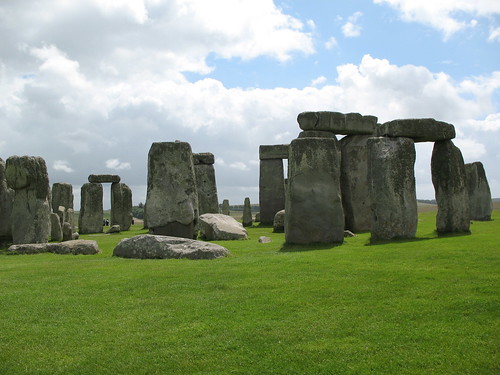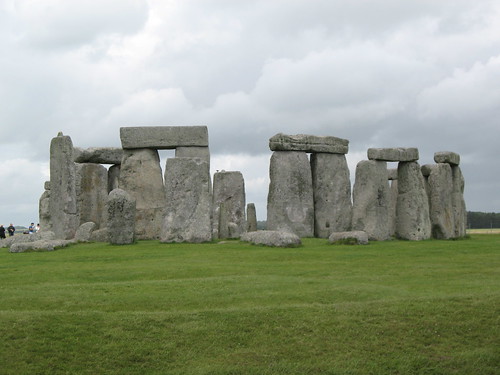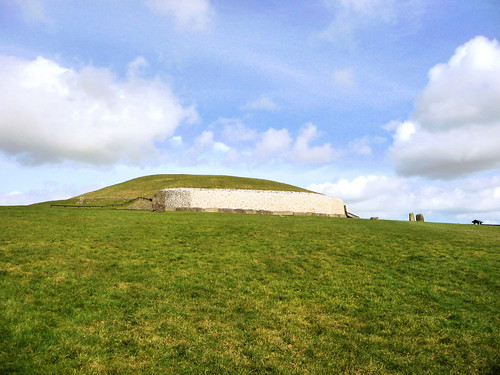Megaliths? Megacool.
- By Faith Tucker
- June 30, 2010
- 3 Comments
The annals of astronomy are riddled with names of some of the Greats of science history; Aristotle, Pythagoras, Galileo, Newton, and Einstein, just to name a few. But astronomy hasn’t always (if ever) fit nicely into the realm of pure scientific inquiry and quantitative fact. Ancient cultures across the world each took their stab at understanding the universe in which they found themselves. For many, this meant looking to the heavens for religious inspiration or understanding, making the sky a source of mythology, worship, and mystery. Astronomy then moved into the realm of philosophy with the Greeks before eventually settling into the world of science, but even today it has managed to keep one lingering foot in the realm of philosophy and religion — but that is a topic for another day.
Today we’re taking a look at one of Astronomy’s ancient predecessors — archeoastronomy. It may seem counterintuitive that archeology could have anything to contribute to astronomy — digging in the dirt is just about as far as you can get from the stars, after all. But ancient civilizations across the globe left us hints and clues about their fascination with the night sky in the form of medicine wheels in North America, Nazca Lines in Peru, Mayan temples like Chechen Itza in Mexico and many more.
Some of the most mysterious and impressive of such structures are the megaliths found primarily in the United Kingdom but also as far west as New Hampshire and as far east as Japan. Megaliths are large stone structures that are usually used as monuments or tombs, but occasionally come with some astronomical tricks up their sleeves as well. And so, off we go to the United Kingdom to explore two extraordinary megaliths — one a recognized icon throughout the world and the other a little known gem of ancient astronomy.
First up is Stonehenge. I’m sure you’ve seen countless pictures of this towering ring of megaliths, at which point you probably absentmindedly wondered to yourself, “How in the world did prehistoric man get that huge rock up there??” before returning to some more productive line of thought. But Stonehenge is more than just an impressive feat of engineering or iconic photo-op. The mammoth stone structures we picture when we think of Stonehenge were erected around 2450 BC, though there is evidence that there have been a progression of wooden and stone structures on this site since 8000 BC. There are numerous ideas floating about concerning the origin and purpose of Stonehenge spanning the spectrum from mundane to ludicrous. Some of the more eccentric proposals attribute its construction to Merlin the wizard from Arthurian legend or assert its purpose to be a landing site for alien spacecraft. More mainstream theories include its use as an astronomical calendar, a place of healing for the physically ailing or the last stop on the path to death. Needless to say, there are a lot of theories out there.
The one thing that everyone does agrees on, however, is that at dawn on the summer solstice a spectacular alignment of the stones causes the sun to rise directly above the famous Heel Stone, casting a beautiful stream of light through the structure. This alignment draws tens of thousands out onto the Salisbury Plain each year to witness the event. There are other astronomical alignments associated with Stonehenge, which lie at the heart of the debate over whether Stonehenge was a holy site where seasonal rituals took place or a scientific observatory that tracked and predicted the motions of the heavens. Perhaps we’ll never know exactly how and why Stonehenge was constructed, but standing at its feet (or Heel, as the case may be) can cause your heart to race as you behold its imposing size, delicate precision, and, perhaps, appreciate its colorful past.
Next, we hop across the Irish Sea to the soft rolling hills of Meath County, Ireland to an ancient tomb that predates Stonehenge. From the outside, Newgrange appears to be nothing but a small hill lined with simple, white stones, but in fact it is an ancient marvel that, in my opinion, trumps Stonehenge in engineering and astronomical acuity. Buried beneath the unimposing hill lies an 18 m-long cruciform passage dating back to approximately 3150 BC. Newgrange has been deeply entangled in Gaelic myth and lore since at least 1100 BC, probably earlier in oral tradition, as the abode of mythological beings and the burial place of pagan kings. However, much of Newgrange’s mythological and cultural relevance was overlooked by the Scots and Brits that overwhelmed Ireland when it was conquered by the Tudors, thus nearly extinguishing the Gaelic literary and learned caste. Its rich history has only recently been fully appreciated.
Beyond its deep cultural heritage, Newgrange is home to one of the most striking and astounding ancient astronomical alignments. The passage is completely submerged in the hill, supported by two rows of orthostats (huge flat stones used to create the walls of the passage) upon which roof slabs are balanced, all of which can be closed off by a large entrance stone. However, an ingenious engineering feature that has come to be called the “roof-box” allows a small stream of light to shine though a small gap between two roof slabs and to illuminate the passage, even with the entrance sealed shut. This clever trick would be nothing more than an energy-efficient lighting system except for the fact that the passage is oriented in such a way that the sun only shines directly through the roof-box at sunrise on the winter solstice for a mere 10-15 minutes. The delicate light of dawn streams through the roof box at precisely the right angle to glance off the perfectly sloped floor and throw light upon the back wall of the passage. The effect is said to be breathtakingly beautiful and a worthy honor to those enclosed in this ancient tomb.
(the above opening is the ‘roof box’ through which the solstice light shines and the lower opening is the top half of the entrance to the passage)
Of course actually being inside Newgrange on the morning of the winter solstice is sadly not a realistic possibility for most of us. So the staff at Newgrange kindly treats visitors to a tour of the passage and an artificial demonstration of what the beautiful moment looks like. Add a little imagination and it might as well be real!
Modern advances in astronomy are constantly unlocking the deep mysteries of the universe and revealing just a taste of the unfathomable macrocosm we live in. These staggering insights challenge the limits of my comprehension, but I’m often equally amazed by man’s irresistible, guiding curiosity and the sheer power of his reasoning throughout history to lay the foundation for the field of study I’ve come to love so much. Today our colossal telescopes and detectors that scan the sky for black holes and gamma-ray bursts are like long lost descendants from these towering megaliths, but are still asking many of the same questions.







[…] NASA Blueshift have released another tour of sites of astronomical interest, this time taking in Stonehenge and Newgrange. […]
Who is this new girl churning out fantastic blog entries!? Is it all her or is there a super-team of ghostwriters over there at NASA?
We may not be willing to give up Faith at the end of the summer. I’m not sure Whitman can have her back, she’s doing such great stuff at Goddard!